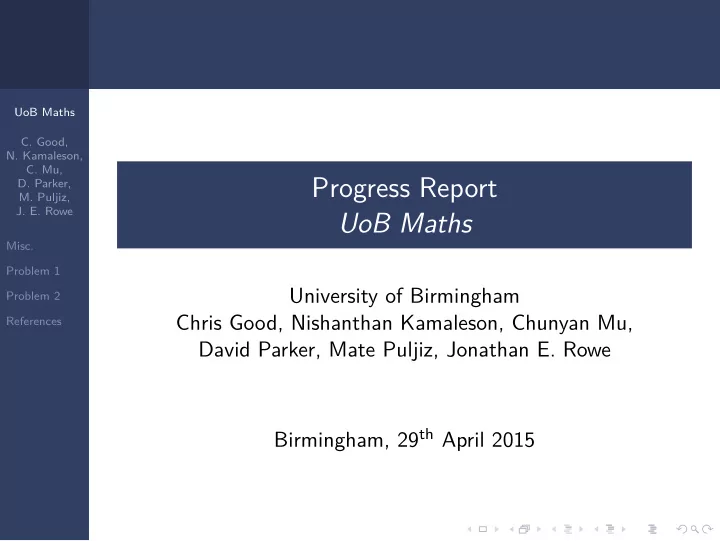

UoB Maths C. Good, N. Kamaleson, C. Mu, Progress Report D. Parker, M. Puljiz, J. E. Rowe UoB Maths Misc. Problem 1 University of Birmingham Problem 2 Chris Good, Nishanthan Kamaleson, Chunyan Mu, References David Parker, Mate Puljiz, Jonathan E. Rowe Birmingham, 29 th April 2015
Lattices for Lagrange interpolation UoB Maths C. Good, N. Kamaleson, C. Mu, D. Parker, M. Puljiz, Recall: J. E. Rowe Finding a valid linear coarse graining = Finding a common Misc. invariant subspace of the differential DT | x Problem 1 Jacobi - Evaluate at random points Problem 2 References If we know that T is a polynomial then e.g. Ben Yaacov and also Chung, Yao give sets of points that suffices to check
Frobenius theorem, Integrability, Foliations UoB Maths Continuous time dynamics on a manifold C. Good, N. Kamaleson, C. Mu, x = � D. Parker, ˙ F ( x ) M. Puljiz, J. E. Rowe regular 1 coarse grainings correspond to foliations Misc. Problem 1 Theorem (Frobenius’ theorem) Problem 2 A subbundle E is integrable if and only if it arises from a References regular foliation of M. (Dimension of leaves + Dimension of E = Dimension of M) Taking � F as the subbundle, FT gives a sufficient condition for existence of coarse graining onto a 1 dimensional manifold, projecting perpendicular to � F 1 level sets are manifolds of constant dimension
UoB Maths C. Good, N. Kamaleson, C. Mu, D. Parker, Integrability condition on � F is M. Puljiz, J. E. Rowe d � F ∧ � F = 0 Misc. Problem 1 E.g. in R 3 this amounts to requiring ( ∇ × � F ) · � F = 0 Problem 2 References But what about CG that aren’t perpendicular to � F ? The extensions seem plausible (and possibly already known).
Dense periodic points in cellular automata UoB Maths C. Good, N. Kamaleson, C. Mu, Alphabet A = { 1 , 2 , . . . , n } D. Parker, M. Puljiz, The full shift Σ A = A Z J. E. Rowe The shift map σ : Σ A → Σ A Misc. Problem 1 σ (( ξ i ) i ) = ( ξ i +1 ) i Problem 2 A cellular automaton is a continuous σ -commuting map References F : Σ A → Σ A . Equivalently ∃ k ∈ N and Φ : A 2 k +1 → A s.t. ( F (( ξ i ) i )) j = Φ( ξ j − k , . . . ξ j + k )
UoB Maths C. Good, N. Kamaleson, C. Mu, ’It is an open problem whether all surjective CA, or at D. Parker, M. Puljiz, least all transitive CA, have a dense set of properly J. E. Rowe periodic points.’ Blanchard Misc. Consider the coarse graining π : Σ A → Σ A 2 k +1 which Problem 1 arranges entries of ξ in groups of 2 k + 1 Problem 2 References It follows that π conjugates F on Σ A to a cellular automaton G on Σ A 2 k +1 but G has depth k = 1 . F is surjective/has periodic points dense iff G is surjective/has periodic points dense
Reaction networks UoB Maths C. Good, N. Kamaleson, C. Mu, Organisation theory D. Parker, M. Puljiz, organisation = closed + self-maintaining J. E. Rowe Misc. Theorem (Dittrich et al.) Problem 1 Problem 2 Given an ODE References x = S v ( x ) , ˙ the abstraction of the stationary state (which is usually attracting) is an organisation. Can this be extended?
UoB Maths C. Good, N. Kamaleson, C. Mu, D. Parker, M. Puljiz, The replicator equation (see in Fontana, Buss) J. E. Rowe Misc. � � a i � a t x i = ˙ j , k x j x k − x i r , s x r x s Problem 1 j r , s , t k Problem 2 What about its stationary state? References Higher order equations? Relation to the heuristic framework?
Connections with other papers UoB Maths C. Good, N. Kamaleson, C. Mu, D. Parker, M. Puljiz, J. E. Rowe Rabitz et al. [’89-’97] study Kinetic differential equations, Misc. their lumpings and stability Problem 1 Problem 2 Equations studied are exactly the replicator equations and References higher order analogues
References I UoB Maths C. Good, N. Kamaleson, C. Mu, D. Parker, [1] Walter Fontana and Leo W Buss, The arrival of the fittest: Toward a M. Puljiz, theory of biological organization , Bulletin of Mathematical Biology 56 J. E. Rowe (1994), no. 1, 1–64. Misc. [2] Peter Dittrich and Pietro Speroni Di Fenizio, Chemical organisation Problem 1 theory , Bulletin of mathematical biology 69 (2007), no. 4, 1199–1231. Problem 2 [3] Alison S Tomlin, Genyuan Li, Herschel Rabitz, and J´ anos T´ oth, The References effect of lumping and expanding on kinetic differential equations , SIAM Journal on Applied Mathematics 57 (1997), no. 6, 1531–1556. [4] Genyuan Li and Herschel Rabitz, A general analysis of approximate lumping in chemical kinetics , Chemical engineering science 45 (1990), no. 4, 977–1002.
References II UoB Maths C. Good, N. Kamaleson, [5] Genyuan Li, Herschel Rabitz, and J´ anos T´ oth, A general analysis of C. Mu, D. Parker, exact nonlinear lumping in chemical kinetics , Chemical Engineering M. Puljiz, Science 49 (1994), no. 3, 343–361. J. E. Rowe [6] K. C. Chung and T. H. Yao, On lattices admitting unique Lagrange Misc. interpolations , SIAM J. Numer. Anal. 14 (1977), no. 4, 735–743. Problem 1 MR0445158 (56 #3502) Problem 2 [7] Ita¨ ı Ben Yaacov, A multivariate version of the Vandermonde References determinant identity , arXiv:1405.0993 (2014). [8] http: //www.encyclopediaofmath.org/index.php/Pfaffian_equation [9] https://www.math.iupui.edu/˜mmisiure/open/FB1.pdf
Recommend
More recommend